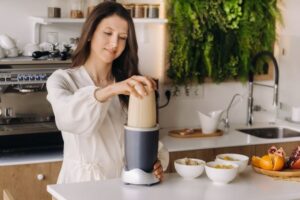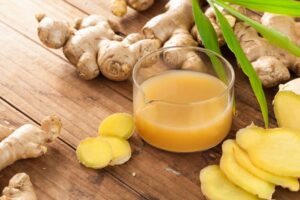
How to grind coffee beans with a blender – Expert Guide & Tips
- Shamima
- May 1, 2023
- 5:27 pm
- No Comments
Are you bored and restless about purchasing pre-ground coffee that doesn’t have the flavor and freshness you want? There’s nowhere else to look! We’ll show you how to grind coffee beans with a blender- Expert Guide & Tips, so you can maximize the flavor of your morning cup with this in-depth instruction. Additionally, you will discover how to set up your blender, measure the ideal coffee-to-water ratio, and modify the time and speed for best outcomes. In addition, we’ll include maintenance advice for your blender and correct storage of ground coffee.
Let’s get started and turn you into a coffee-grinding pro!

Coffee is a popular and essential beverage in many people’s daily routines worldwide. The most important thing to get a delicious cup of coffee is grinding and roasting it before brewing. There are lots of tools and methods used to grind coffee beans. However, like a coffee beans grinder, a blender is an effective and easy tool to use. Let’s get into how to grind coffee beans with a blender.
Wait a moment! Before we get into that, what is the bonus in this article? Tips for grinding coffee for cold brew. This gives the same result as using a French press grind. In addition, you get to know the best blenders for the job and how to get the perfect grind size (it’s your lucky moment!).
How to grind coffee beans at home
Ensuring your blender is in the right state before use is essential. To do so, clean your blender thoroughly and remove any leftover food particles. Next, make sure that the blades are sharp and in good condition. Dull blades can result in uneven grinding and a less flavorful cup of coffee.
Also, choose a blender that can handle the coffee beans you want to grind. The importance can’t be over-emphasized. Overloading the blender can be bad for the grind as well.
Here, we will dissect how to grind coffee beans with a blender from interviews with experts. However, know that your preference commands how you will grind your coffee. To grind coffee for cold brew, you should embrace a coarse approach.
Conversely, if you adopt a finer brewing method, you likely want an espresso. Espresso is better enjoyed while brewed hot. That said, check out these steps for using a blender:
Start by weighing the desired amount of coffee beans. This is because whole coffee beans have a longer shelf life than ground ones. Thus, only take the amount for immediate use.
- Add the coffee beans to the blender.
- Press and grind in short bursts.
- Check the grind size frequently by removing the lid. After which, you check the consistency of the coffee grinds.
- Blend until you have achieved the desired grind size.
Generally, Coffee experts recommend grinding coffee beans with a blender in short bursts. This prevents you from overheating the blender and achieving an uneven grind. It’s also vital to start with a small amount of coffee beans. After which, you experiment with different grind sizes to achieve the desired flavor.
Why do you grind coffee beans with a blender?
You wouldn’t want to consume lumps of beans in your beverage, right? Best advice: grind these beans before brewing! Generally, specialized grinders exist for beans or coffee beans. Grinding coffee beans is vital in making a great cup of coffee. Also, grind the beans only when you are ready to brew. It helps preserve the coffee’s freshness and flavor.
Grind size also plays a significant role in determining the taste of your coffee. Espressos put “finer grind” into good use, while the French press does the same for “coarse ones.” A blender can serve as a grinder for beans if you don’t have a coffee grinder. It is a cost-effective solution for those not wanting to invest in a coffee grinder.
In summary, you grind whole coffee beans before consuming. After grinding, you can get it in two main textures: Fine or coarse. The coarse-ground coffee produces milder coffee from the French press grind brewing method. In contrast, the finer grind makes concentrated coffee. Also, note that you will stick to the coarse texture if you love to grind coffee for cold brew.
What kind of blender is the best for grinding coffee beans?
Blenders are not created equally. While most blenders won’t grind the coffee properly, some will perform exceptionally. In addition, some are better suited for the task. A high-speed blender with sharp blades is ideal for grinding coffee beans. However, if you’re using a standard blender, you may need to blend the coffee beans for longer. By doing this, you will achieve the desired grind size.
The Vitamix blender and Ninja blender are some of the best for coffee beans. Their high-speed blades grind coffee beans into powder in seconds.
How to grind coffee beans in a Vitamix blender?
A Vitamix blender has a similar procedure to follow, as discussed above. However, this section will narrow down how to grind coffee beans with a blender to using Vitamix. Most blenders have the same controls. However, we will explain in specific to Vitamix blender.
The Vitamix blender is one of the best blenders for grinding coffee beans. It can come as a personal blender or a commercial blender. To grind coffee beans in a Vitamix, follow the below steps:
- Start by weighing the desired amount of coffee beans.
- Add the coffee beans to the dry grains container.
- Click on “Variable speed 1” and slowly increase to “Variable speed 8” or as you may desire.
- 10-15 seconds is enough for this.
- Check the grind size and blend for additional time if needed. You may decide to brew cold coffee right away in the blender.
Tips for getting the perfect grind
Knowing how to grind coffee beans with a blender is incomplete if you don’t remember some hacks. Grinding coffee beans with a blender can be easy and effective if you follow these tips:
- Use a kitchen scale to measure the coffee beans and ensure consistent results.
- Start with a small amount of coffee beans. Grind a small amount at a time. It can result in a more consistent grind size.
- Use a high-speed blender like a Vitamix blender, with sharp blades and a powerful motor.
- Blend in short bursts. This avoids overheating the machine and achieving an uneven grind.
- Check the grind size. Do this frequently by removing the lid and checking the consistency of the grounds.
- Clean the blender to avoid cross-contamination thoroughly before and after use.
- Experiment with different grind sizes based on your brewing method. Do this to achieve the desired flavor.
- Grind coffee beans right before brewing to ensure the coffee is as fresh as possible.
Common mistakes: You should avoid
Everyone makes mistakes with things. Delicious beverages like coffee aren’t left out of this pool. Over time, studies of common errors while grinding your beans have been made. You will find an explanation for these mistakes below. We do not want you to fall into the same hole! As earlier said, how to grind coffee beans with a blender is an art. You can perfect this art by avoiding these mistakes:
Overheating the motor:
Coffee beans are generally hard in texture. Thus, blending too long or too many coffee beans at a go can overheat the engine. This can create a ripple effect that spoils your blender untimely.
Using stale or low-quality coffee beans:
Yes! We know throwing away those beans when they become stale could sometimes be sad. However, they can affect the taste and aroma of the coffee.
Grinding the coffee beans:
Don’t grind too fine or coarse for brewing. This results in under-extraction or over-extraction of the coffee. Thus, keep it moderate.
Final words
Choosing a blender to grind your beans is an alternative to a coffee grinder. You can achieve a consistent grind size with the right blender and technique. Of course! This will be suitable for various brewing methods. However, avoiding common mistakes and constantly checking the grind size is essential. It ensures your coffee is as fresh and delicious as possible. We hope you now have expert knowledge of how to grind coffee beans with a blender.
Some Frequently Asked Questions
Can grinding coffee beans with a blender damage your blender?
Yes, it can, especially if it is not a blender built for that purpose. Overall, we advise using a coffee grinder or dedicated blenders.
How much coffee should I grind at once?
It depends on factors like blender capacity and brewing method. A French press grind uses a rule of thumb of 1:15. One part coffee to Fifteen parts of water. To be safe, grind 20-30 grams (0.7-1 ounce) of coffee beans at once.
What are the other ways to grind coffee?
1. Manual coffee grinder.
2. Mortar and pestle.
3. Rolling pin.
4. Food processor.
How to use a coffee grinder?
- Choose the right grinder, e.g., burr grinders.
- Measure your beans.
- The grind settings: If you have a burr grinder, adjust the grind settings. This helps achieve the desired coarseness. For instance, if you are making French press coffee, you will want a coarse grind. For an espresso, you will want a fine grind.
- Start the grinder: Let it run from a few seconds to a minute.
- Check the grind: After grinding, check the grind size to ensure it is correct. You can look at the grounds or feel them between your fingers.
What is best for grinding coffee without a grinder – a blender or a food processor?
A blender. Food processors are not designed to handle the hard shells. However, you may get a powerful food processor that can handle the coffee beans.
What is the recommended grinding time for medium-sized coffee beans?
Coffee beans should be ground for 10 to 12 seconds, grinding in small bursts, until the grind size is medium. To prevent overheating the beans, don’t forget to pulse the blender, and continuously check the consistency to make sure the correct texture is achieved.
What Temperature of Water Is Best For Brewing Coffee After Grinding?
After grinding, 195–205°F (90–96°C) is the perfect water temperature for brewing coffee. This temperature range makes sure that the tastes of the coffee grinds are extracted as best they can, giving you a rich, flavorful cup of coffee.
How Often Should My Blender Be Cleaned And Maintained When Grinding Coffee Beans?
When grinding coffee beans, make sure your blender is maintained and cleaned after each use for best results. By keeping your blender clean regularly, you may enjoy freshly ground coffee every time and prevent residue buildup.
Table of Contents
ToggleShamima
I am working in a restaurant. One of the responsibilities is to monitor the Kitchen Appliances’ performance and inform the maintenance department. Sometimes, I work closely with the maintenance team. I have gained some knowledge of kitchen appliances from there and want to share it with you. I have a passion for explaining my understanding simply.
DISCLAIMER
Ponnopick intends to provide guidelines other than advice. We help buyers better understand the product.
INCOME DISCLOSURE
We have used affiliate links in the articles, and we may earn a commission through successful purchases from that links.










